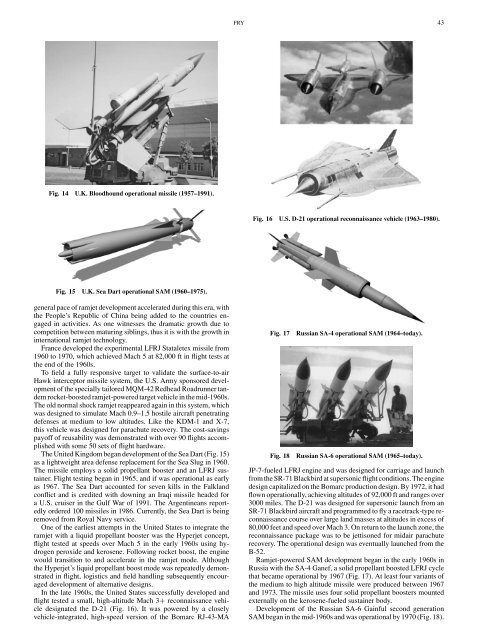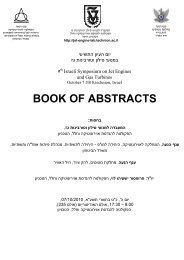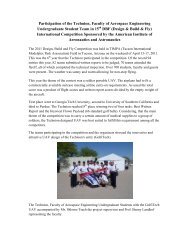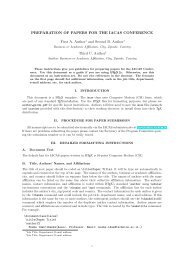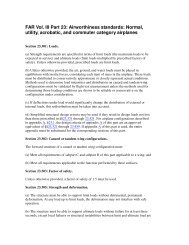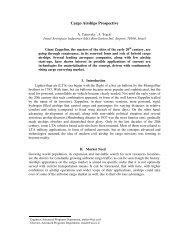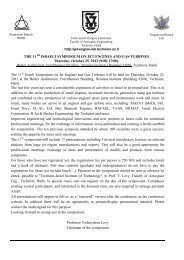A Century of Ramjet Propulsion Technology Evolution - Faculty of ...
A Century of Ramjet Propulsion Technology Evolution - Faculty of ...
A Century of Ramjet Propulsion Technology Evolution - Faculty of ...
You also want an ePaper? Increase the reach of your titles
YUMPU automatically turns print PDFs into web optimized ePapers that Google loves.
Fig. 14 U.K. Bloodhound operational missile (1957–1991).<br />
Fig. 15 U.K. Sea Dart operational SAM (1960–1975).<br />
general pace <strong>of</strong> ramjet development accelerated during this era, with<br />
the People’s Republic <strong>of</strong> China being added to the countries engaged<br />
in activities. As one witnesses the dramatic growth due to<br />
competition between maturing siblings, thus it is with the growth in<br />
international ramjet technology.<br />
France developed the experimental LFRJ Stataletex missile from<br />
1960 to 1970, which achieved Mach 5 at 82,000 ft in flight tests at<br />
the end <strong>of</strong> the 1960s.<br />
To field a fully responsive target to validate the surface-to-air<br />
Hawk interceptor missile system, the U.S. Army sponsored development<br />
<strong>of</strong> the specially tailored MQM-42 Redhead Roadrunner tandem<br />
rocket-boosted ramjet-powered target vehicle in the mid-1960s.<br />
The old normal shock ramjet reappeared again in this system, which<br />
was designed to simulate Mach 0.9–1.5 hostile aircraft penetrating<br />
defenses at medium to low altitudes. Like the KDM-1 and X-7,<br />
this vehicle was designed for parachute recovery. The cost-savings<br />
pay<strong>of</strong>f <strong>of</strong> reusability was demonstrated with over 90 flights accomplished<br />
with some 50 sets <strong>of</strong> flight hardware.<br />
The United Kingdom began development <strong>of</strong> the Sea Dart (Fig. 15)<br />
as a lightweight area defense replacement for the Sea Slug in 1960.<br />
The missile employs a solid propellant booster and an LFRJ sustainer.<br />
Flight testing began in 1965, and if was operational as early<br />
as 1967. The Sea Dart accounted for seven kills in the Falkland<br />
conflict and is credited with downing an Iraqi missile headed for<br />
a U.S. cruiser in the Gulf War <strong>of</strong> 1991. The Argentineans reportedly<br />
ordered 100 missiles in 1986. Currently, the Sea Dart is being<br />
removed from Royal Navy service.<br />
One <strong>of</strong> the earliest attempts in the United States to integrate the<br />
ramjet with a liquid propellant booster was the Hyperjet concept,<br />
flight tested at speeds over Mach 5 in the early 1960s using hydrogen<br />
peroxide and kerosene. Following rocket boost, the engine<br />
would transition to and accelerate in the ramjet mode. Although<br />
the Hyperjet’s liquid propellant boost mode was repeatedly demonstrated<br />
in flight, logistics and field handling subsequently encouraged<br />
development <strong>of</strong> alternative designs.<br />
In the late 1960s, the United States successfully developed and<br />
flight tested a small, high-altitude Mach 3+ reconnaissance vehicle<br />
designated the D-21 (Fig. 16). It was powered by a closely<br />
vehicle-integrated, high-speed version <strong>of</strong> the Bomarc RJ-43-MA<br />
FRY 43<br />
Fig. 16 U.S. D-21 operational reconnaissance vehicle (1963–1980).<br />
Fig. 17 Russian SA-4 operational SAM (1964–today).<br />
Fig. 18 Russian SA-6 operational SAM (1965–today).<br />
JP-7-fueled LFRJ engine and was designed for carriage and launch<br />
from the SR-71 Blackbird at supersonic flight conditions. The engine<br />
design capitalized on the Bomarc production design. By 1972, it had<br />
flown operationally, achieving altitudes <strong>of</strong> 92,000 ft and ranges over<br />
3000 miles. The D-21 was designed for supersonic launch from an<br />
SR-71 Blackbird aircraft and programmed to fly a racetrack-type reconnaissance<br />
course over large land masses at altitudes in excess <strong>of</strong><br />
80,000 feet and speed over Mach 3. On return to the launch zone, the<br />
reconnaissance package was to be jettisoned for midair parachute<br />
recovery. The operational design was eventually launched from the<br />
B-52.<br />
<strong>Ramjet</strong>-powered SAM development began in the early 1960s in<br />
Russia with the SA-4 Ganef, a solid propellant boosted LFRJ cycle<br />
that became operational by 1967 (Fig. 17). At least four variants <strong>of</strong><br />
the medium to high altitude missile were produced between 1967<br />
and 1973. The missile uses four solid propellant boosters mounted<br />
externally on the kerosene-fueled sustainer body.<br />
Development <strong>of</strong> the Russian SA-6 Gainful second generation<br />
SAM began in the mid-1960s and was operational by 1970 (Fig. 18).


